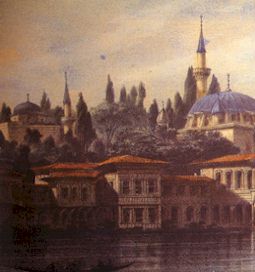
Esma Sultan Palace, Eyup
(Eugene Flandin,Lithografic Print)
Istanbul, the cradle of various cultures, has always been a source of inspiration for Turkish and foreign artists where paintings reflect the captivating effect of this marvellous city on people who had the chance of admiring its beauties.
An interest developed for Istanbul where various cultures lived along the centuries at the end of l8th century in the West and increased towards the beginning of l9th century. It was also a result of the interest for the Eastern countries. Tourists visiting Istanbul, already had an idea about the city through the travel notes they had read and / or the engravings they had seen. The travelers and the artists who spent sometime in the city transferred their impression to the west by their writings and engravings and this information created an Eastern image in the western eye.
(1)
In fact the interest towards Istanbul started in very earlier periods. Thirteen albums of foreign origin describing Istanbul in the l6th century are in Europe and in the United States. Some of the travelers and artists who had various writings and paintings in their artworks are:
Pieter Coecke van Aelst, Melchior Lorichs, in the l6th century;
Jan de Thevenot in the l7th century;
Cornelius de Bruyn, J.P. Tournefort in the l8th century
J.b. van Mour (1671-1737), J.E. Liotard (1702-1789), A. de Favray (17061798), Luigi Mayer (1755-1803); and in the l9th century, Antoine Ignace Milling (1763-1831), Armand Charles Caraffe (1762-1822), L.F. Cassas (1756-1827), A.L. Castellan (1722-1838), L.F. Fauvel (17531838), J.B. Hilair (1753-1822), Thomas Allom (1804-1872), William Bartlett (1809-1854), Eugene Flandin (1809-1876), Alexandra Gabriel Decamp (1803-1860), Amedeo Preziosi (1807-1882), Germain Fabius Brest (1823-1900), Ivan C. Ayvazowsky (1817-1900) (22 years between 1839-1861, during Abdulmecit period).
Russian Ayvazowsky of Armenian origin came to Istanbul first in 1845 and then twice more in the same period. He stayed in Istanbul two months in 1874 (Abdulaziz Period) and then visited Istanbul eight times and he painted a portrait of Murat V ; in 1888 (Abdulhamit II period) he came to Istanbul for the last time and joined an expedition.
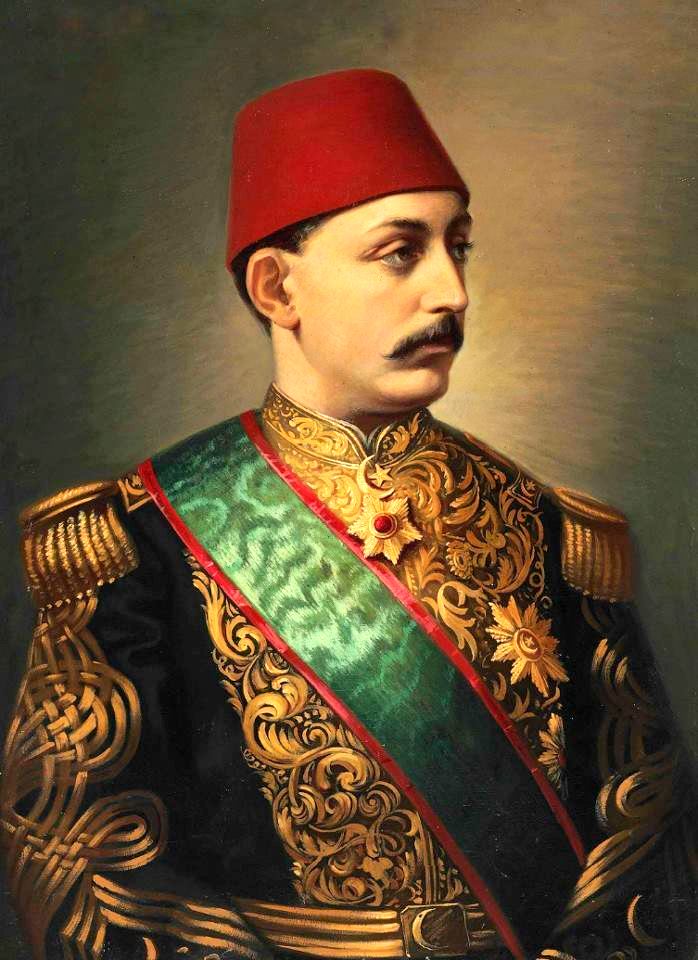
In this long period of time he had chance to meet four Sultans and to present his paintings. G. Jea Brindesi (l9th Century) Francois Dubois (1790-1871 ), Jean Leon Gerome (1824-1904) (his first visit was in 1854 (Abdulmecid Period), and then he came again in 1875 (Abdulaziz Period) and in 1879 (Abdulhamit II Period), Pierre Desire Guillemet (1827-1878), (Guillemet who was one of the artists who worked for Abdulaziz, established the first private academy with the help of Sultan in Beyoglu Kullugu Street where he and his wife taught western style drawing and painting. Sarkis Direnyan and Civanyan who stayed in Paris for a long time had their education here) Francois Claude Hayette(1838-?) , Adolf Kaufmann (1848-1916), Gaspare Fossati (1809-1883), Guiseppe Fossati (1822-1891 ), Felix Parmentier (1821 – ?) Joseph Schranz (1803-1872), Sandor AIexander Swoboda (l9th century), Salvatore Valeri (1857-1946), Joseph Warnia Zarzecki (1850 – ?) F. Leonardo de Mango (1843-1930), Jean Lecomte du Nouy, Rudolf Ernst, John Singer Sargent, Adrien Dauzats, Charles Gleyre, Jacob Jacobs, Stanuslaus Chlebowski and towards 20th century, Fausto Zonaro (1854-1929), Felix Ziem (1821-1911), Paul Signac (1863-1935), Theo van Rysselberghe (1862-1926), Philippe Bello (1831- 1911 ), (Since Bello got married in Istanbul in 1866, he arrived a short time before that date which means in Abdulaziz Period), Narcisse Berchere (1891-1919).
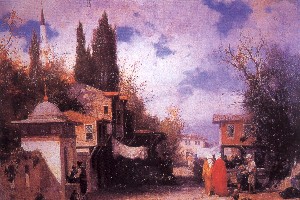
A Street in Uskudar
(Germain-Fabius Brest,Oilpainting,Topkapi Palace)
(2)
These observers were not always realistic in their impressions. The writers sometimes were influenced by the fairy tales of the East like “Thousand and One Night Stories”
(3)
The memories the Western travelers wrote down are quite important for the research studies conducted about Ottoman History. Nicola lorga who comprehended it, makes clear in his work
(4)
That many times a traveler is preferred to a historian. No doubt, an impartial traveler’s descriptions might give extremely important clues. People who wrote travelers’ notes used to describe the most outstanding features of the place where they had first been.Besides various features it has,Istanbul was also a city of art, and equal to Rome, Venice, Amsterdam and even it was more outstanding from the point of being “Picturesque”
(5)
Most of the artists had to be left in private collections since they were not important enough to take a place in Western museums.
(6)
Besides the important foreign artists, Ottoman artists also used Istanbul as a subject as well.
(7)
We find Istanbul siceneries also in miniatures which are the foundation of Turkish painting art, with Matrakci Nasuh, since 16th century.
(8)
“Surname dated 1582 was illustrated by Nakkas Osman. In this work of art showing the circumcision ceremony of Prince Mehmet, the son of Sultan Murat III, Sultanahmet Square, Ibrahim Pasha Palace, and various scenes of life in Istanbul also take place.
(9)
Wall paintings seen in later centuries are also important for the depictions of Istanbul. It was natural to prefer non-figurative subjects such as flowers, fruits and scenery for the painting coming out of the books and taking places on the walls.This manner which was a result of public belief strengthened the education of topography and technical drawing since the beginning of the 19th century.
(10)
In this period, since the understanding of western painting was accepted a great deal, we see scenery depictions on wall paintings as well. This painting style which gave its first examples on Harem walls in Topkapi Palace and in Yozgat Capanoglu Mosque and in Soma Hizir Bey Mosque in Anatolia carried on until the 20th century.
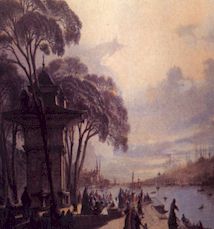
Mihrisah Sultan fountain in Kucuksu,Bosphorus
(Eugene Flandin, Lithografic Print)
(11)
Scenery depictions in Anatolia can be considered in two groups. 1. Depiction of a specific locations. 2. Depiction of imaginary locations.
In the first group, we observe Mecca and Medina.
In the other examples which give the impression that they are the depictions of a specific location, we mostly see Istanbul. In Balkans, we know various imaginary depictions of Istanbul. We find quite interesting Istanbul sceneries in these depictions. These are quite common. In those examples, it is not possible to identify the location.
The sceneries do not take place inside houses according to a specific rule. There is no rule in selecting the place and the subject.In an ordinary house, such as Bahaeddin Aga Mansion in Milas where there was a simple daily life, a depiction of a harbor and a castle could take place on sofa walls or in a religious place such as the mihrap partition of Soma Hizir Bey Mosque, a large composition of still life with watermelon slices and other fruits were painted
(12)
The artists who made scenery paintings in Western technique were named as the “Primitives” in Turkish fine arts; but this is not the right definition. Seker Ahmet Pasha, Osman Hamdi Bey, Halil Pasha, Suleyman Seyyid and other artist had already produced their work of art in Western technique and had steered Turkish fine arts
(13)
The artists of this period painted various locations of Istanbul generally without any human figures. Some of these artists are Kasımpasalı Hilmi, Salih Molla Aski, Osman Nuri, Giritli Huseyin, Ahmet Bedri, Mustafa,Ahmet Ziya Sami, Fahri Kaptan,Ahmet Bicakcilar and Sevki
(14)
No doubt, these are Istanbul artists,but they generally chose palaces, parks, gardens and such places and since they felt better in arreas surrounded by walls,they were not willing to work in crowded public areas. It is difficult to say whether the reason was the desire of not being seen in public with painting materials in hand since it wasn’t tolerated to paint, or the preference of painting locations belonging to the Sultan so that they could gain his sympathy.
(15)
The habit of choosing such places continued until the artists of the “1914 generation” who started to work in external areas.
(16)Even Seker Ahmet Pasha and Osman Hamdi Bey followed thes same tradition.
(17)
There were city portrait artists as well as human portrait artists. Istanbul had its painters just like Venice had Canaletto and Guardi to paint it
(18)
Among those artists, Halil Pasha, Hodja Ali Riza, Ibrahim Calli, Nazmi Ziya Guran,Feyhaman Duran, Huseyin Avni Lifij, Namik Ismail, and Hikmet Onat are the important names.The windows of artist studios were opened to Istanbul in 1914. “the 1914 generation” supported Halil Pasha and Hodja Ali Riza to get rid of military, palaces, mansions,parks and gardens and brought ” open air art” into a very good position.
(19)
Later on many important names joined the adventure of Istanbul Artists. Sevket Dag with his mosques, Turgut Zaim with his examples from old Istanbul daily life and “Orta Oyunu”,Cemal Tollu and Cevat Dereli, the founders of “Group D”, Bedri Rahmi Eyuboglu who painted differend city sceneries though he is from the Black Sea region and painted taverns where Fikret Mualla who had a tragic life and his friends Fikret Adil, Abidin Dino,Neyzen Tevfik and others went, Ercument Kalmik with his magnificent harbor and boat paintings, and Cihat Burak with his lots of work about Istanbul, and many others who we don’t mention here.
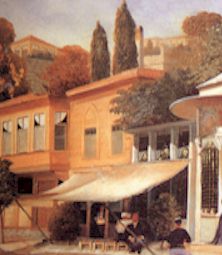
The Fountain
(Anonymous)
FOOTNOTES
(1) Ahmet Kamil Goren, “Istanbul Ressamlari”, Artist Plastik Sanatlar Dergisi, p.20, Istanbul, Mayıs 1993, pp.l6-17; Necla Arslan, Gravur ve Seyahatnamelerde Istanbul, 18. Yuzyil Sonu ve 19. Yuzyil, Istanbul 1992, p.27.
(2) Sezer Tansug, Cagdas Turk Sanati, Istanbul, 1986, p.40; Semra Germaner-Zeynep Inankur, Oryantalizm ve Turkiye, Turk Kulturune Hizmet Vakfi Sanat Yayinlari, Istanbul 1989, pp. 5-6,82-83,91-92, 95, 121, 132, 153,167; Adolphe Thalasso, L’Art Ottoman, Les Peintres de Turquie, Paris(1910), (Tipki Basim Arkeoloji ve Sanat Yayinlari, Istanbul 1988, p. 11; Mehmet Ozel, Ressamlarin Fircasindan / From the Paintbrush of the Artists, Kultur Bakanligi, Ankara 1995, pp.8-9.
(3) Reinhold Schiffer, “Estetik Bir Obje Olarak Istanbul, 19. Yuzyil Basi Ingiliz Seyahat Edebiyatinda bir Dogu Sehrinin Imaji “, Kaynaklar, Sekerbank Kultur Yayini, s. 3., 1984, p. 29; Nurullah Berk, Turk
ve Yabanci Resminde Istanbul, T.Turing, Istanbul, P.12.
(4) Nicola Lorga, Les Voyageurs Francais Dans L’Orient European, Paris 1929, pp.5-6
(5) Zeki Arikan, XV-XVII . Yuzyilda Avrupali Gezginlerin Gozlemleri, Ege Universitesi Edebiyat Fakultesi, Izmir 1988, p.8
(6) Nurullah Berk, Turk ve Yabanci Resminde Istanbul, T.Turing, Istanbul, p.1
(7) Berk, op. cit., Ibit.
(8) Berk, op. cit., p. 12.
(9) Mehmet Ozel, Res.Firc.Istanbul, p. 9
(10) Gul Irepoglu, “Osmanli Minyatur Sanatinda KIasik Donem”, Turk Kulturunde Sanat ve Mimari, 21. Yuzyil Egitim ve Kultur Vakfi, Istanbul 1993, p. 81; Nurhan Atasoy-Filiz Cagman, Turkish Miniature Painting, Istanbul 1974, p.39; Mehmet Ozel, Rep.Firc.Istanbul, p. 9
(11) Gunsel Renda-Turan Erol, Baslangicindan Bugune Cagdas Turk Resim Sanati Tarihi, C.1; Istanbul, 1980, p. 102
(12) Ruchan Arik, Batililasma Donemi Anadolu Tasvir Sanati, Kultur ve Turizm Bakanligi Yayini, Ank. 1988, p. 120-134, (Ilk baskisi Is Bankası Ank. 1975); Ahmet Kamil Goren, “Ambelakia’da Hayali Istanbul Betimlemeleri 5.27, Antik-Dekor S.27, Istanbul Aralık 1994, pp.76-81.
(13) Ahmet Kamil Goren, “19.Yuzyil Turk Sanatcilarinin Ortak Ozellikleri ve Primitifler ve Darussafaka’li Ressamlar Sorunu Uzerine”, Sanat ve Cevresi, S.193, Istanbul Kasim 1994, pp.52-55.
(14) Berk, op. cit, p.13; Goren, op.cit., Ibid
(15) Berk, op. cit. p.14
(16) Berk, op. cit., Ibid
(17) Berk, op.cit., p.15
(18) Berk, op. cit., p.18
(19) Berk, op. cit., p. 22; Mehmet Ozel, Rep. Firc. Istanbul, p.9
(20)Berk, op. cit., p. 32-41; Mehmet Ozel, Rep. Firc. Istanbul, p.9.
